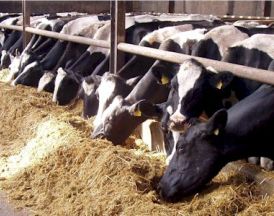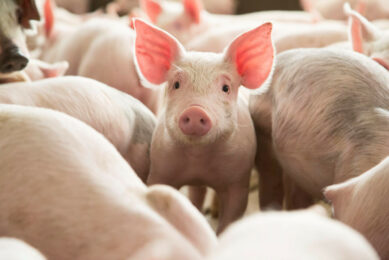Dairy Solutions Symposium: pH not only cause for acidosis

On the 1st and 2nd of July, animal nutrition company Alltech organised the Dairy Solutions Symposium in Utrecht, the Netherlands. Lots of discussion was initiated about the causes and effects of SARA, sub-acute ruminal acidosis.
Sub-acute ruminal acidosis (SARA) is increasingly being seen as a major nutritional problem which affects the high yielding, modern dairy herd, and it has been linked to high herd culling rates. SARA is a group problem and is a disorder of ruminal fermentation that is characterised by extended periods of depressed ruminal pH below 5.5-5.6. For optimum ruminal fermentation and fibre digestion, ruminal pH should lie between 6.0 and 6.4, although even in healthy cows, it will fluctuate below this level for short periods during the day.
Is SARA a cause or effect?
However, still many uncertainties exist about the exact causes and implications of SARA. In the presentation of Dr. Joachim Kleen from Alta Genetics in Germany said that a clear definition of SARA is difficult to define. Kleen posed the question whether a pH of 5.5 a suitable threshold is for SARA and secondly he said that there is uncertainty on how correctly to interpret pH values in order to justify the diagnosis of SARA. He further addressed that the occurrence of SARA might be an indicative of herd health problems and not a health problem per se. You could question: is the cow lame because of SARA of does the cow develop SARA because of the lameness (or other problems).
Rumen clearance important
Dr. Jan Dijkstra from Wageningen University in the Netherlands explained that a low ruminal pH for prolonged periods each day (due to volatile fatty acids (VFA) and sometimes lactic acid) may affect feed intake, microbial metabolism and nutrient degradation. Dijkstra mentioned that there are many factors involved in the pH regulation and that clearance of VFA in the rumen is essential to maintain the rumen pH on an acceptable level. Clearance of VFA is determined by passage in the liquid phase and by absorption through the rumen wall.
Effect of free LPS
Dr. Kees Plaizier from the University of Manitoba in Canada focused his presentation on the relationship of lipopolysaccharide (LPS) and SARA. LPS is a component of the outer membrane of gram-negative bacteria, which is released during rapid growth or through lysis. Free LPS is an endotoxin and a pyrogen. Several symptoms of SARA may be due to translocation of LPS from the gastro-intestinal tract into the blood circulation. Plaizier explained a study in which SARA was induced by two diets (grain based and alfalfa based). In this study, the free LPS in the faeces was measured after feeding these diets. He found that more free LPS was found in the grain based diet and also that cows with a higher milk yield had an higher level of free LPS in the manure. To prevent LPS related health problems, Plaizier mentioned to enhance the barrier function in the gastro-intestinal tract or to bind LPS in some sort of way. He concluded by addressing that we have to look at SARA as a problem beyond the rumen, as it is a more complex problem than we think it is.
SARA under farm conditions
Ing. Paul Dobbelaar from Utrecht University in the Netherlands gave a practical presentation about the control of rumen acidosis under farm conditions. Dobbelaar explained that when highly digestible forages are fed to dairy cows, the ration does not necessarily provide enough "physical structure". This may result in SARA. Dobbelaar named a few measures that prevent the formation of SARA. These are: prevent a high proportion of concentrates during the first five days after calving, do not chop the maize silage too fine (recommended is 6-8mm minimum), don’t leave the cows on the same paddock for too long, don’t mow all the paddocks at the same time (leave some variation in grass length among the paddocks), inclusion of by products that support rumen health such as brewers grain, pressed beet pulp and maize gluten.
Link with laminitis
Dr. Finbar Mulligan from the University College Dublin in Ireland discussed SARA and rumen pH in grazing dairy cows. As an example, Mulligan named a typical dairy farm in Ireland where for approx. 85% of the grazing year, the diet is composed of high quality swards that are dominated by perennial ryegrass. In this system, the cow often required to walk several kilometres per day to and from milking. Therefore, one reason for concern about low rumen pH and SARA is due to their link with laminitis, lameness and dairy cow welfare. Mulligan named two recent studies, one from Ireland and one from Australia that looked into the prevalence of SARA. These studies report that between 10 and 12% of grazing dairy cows had a rumen pH of less than 5.5. From a recent study – done at the University College Dublin – it was concluded that dairy cows fitted with in-dwelling rumen pH monitors were found to have a greater number of hours below rumen pH 5.5 and higher levels of lactic acid in rumen fluid after abrupt introduction of pasture in comparison to gradual introduction to pasture in early lactation.
Other speakers at the symposium were: Prof. Daniël de Brabander, Prof. Sergio Calsamiglia, Dr. Juan Tricarico, Dr, André Bannink, Prof. Holger Martens, Prof. Veerle Fievez, Prof. Johanna Fink-Gremmels and Prof. Kerstin Müller.
Click here for the PHOTOS.
[By E. Koeleman]











